Alhambra – the so-called grandiose architectural and park complex in southern Spain. It is located on the east side of the city of Granada, on the spacious top of La Sibina hill. An ancient fortress, lush gardens and cozy courtyards with fountains, mosques, the royal palace – the Alhambra combines many beauties hidden behind powerful fortress walls. Moreover, the entire territory is divided into several zones, along which the development path of the ensemble is traced.
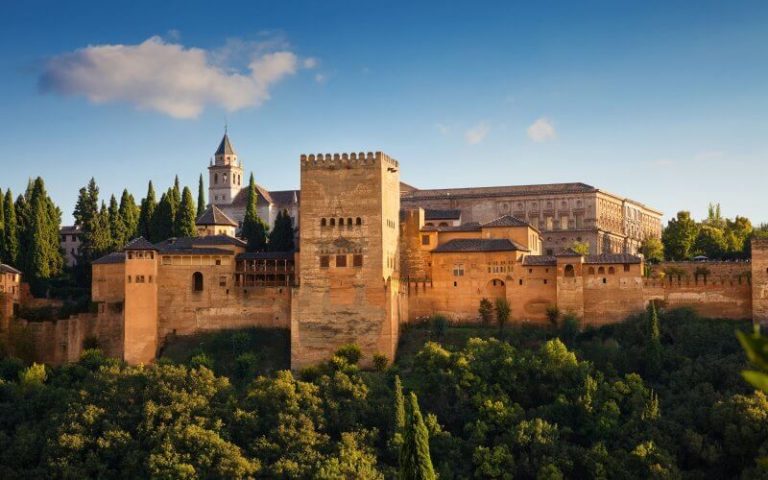
History of the Alhambra
In the eighth century, southern Spain came under the rule of Muslim conquerors. Muhammad ibn Nasr, who declared himself emir, decided that the capital of his possessions would be Granada. In 1238, he began the construction of his residence: the fortress and castle of the Alhambra.
All the time, while the Nasrid dynasty (1230-1492) was in power in the Granada emirate, Moorish architects and engineers built new castles and mosques, they literally created the “eighth wonder of the world.” That period was the “golden age” of Granada, because the emirate was the richest state in Spain.
The Alhambra Palace in Granada was the last refuge of Islam in southern Spain. At the end of the 15th century, the entire Pirinei Peninsula was liberated from the Moorish, and the royal residence was established in the Alhambra. When a new castle was built for Charles V in the 16th century, many of the original buildings were demolished, and the rest were badly damaged by the earthquake in the 16th century.
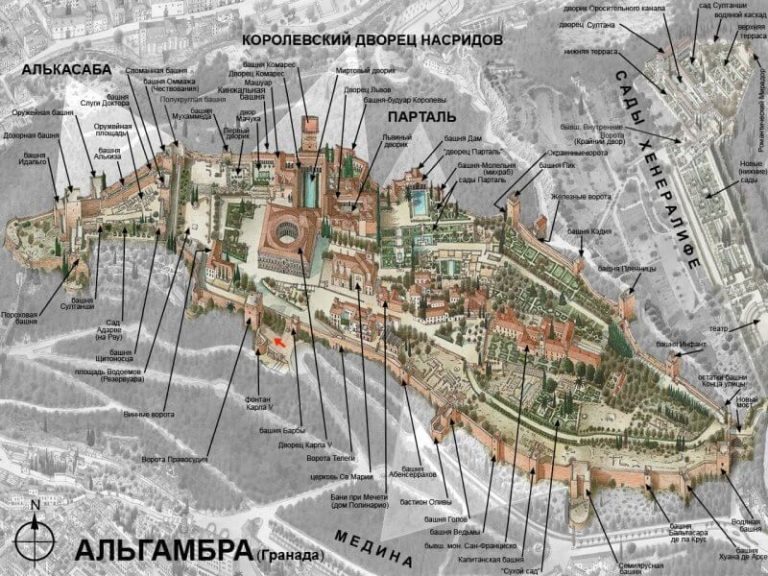
Around the middle of the XIX century, the Alhambra began to be restored, but the first stage of work, which lasted about 60 years, was not very successful. Only in the twentieth century the ensemble was returned to its historical image.
Now the Alhambra in Granada is the most famous attraction in Spain. Every year, over 2,000,000 tourists from all over the world come here.
Historical fact! Many creative people visited the Alhambra and drew inspiration here: Irving, Byron, de Chateaubriand, Hugo, Bulwer Lytton.
Alcazaba
The Alcazaba, part of the Alhambra in Spain, is the oldest citadel in which the first emirs from the Nasrid dynasty lived before they built new castles.
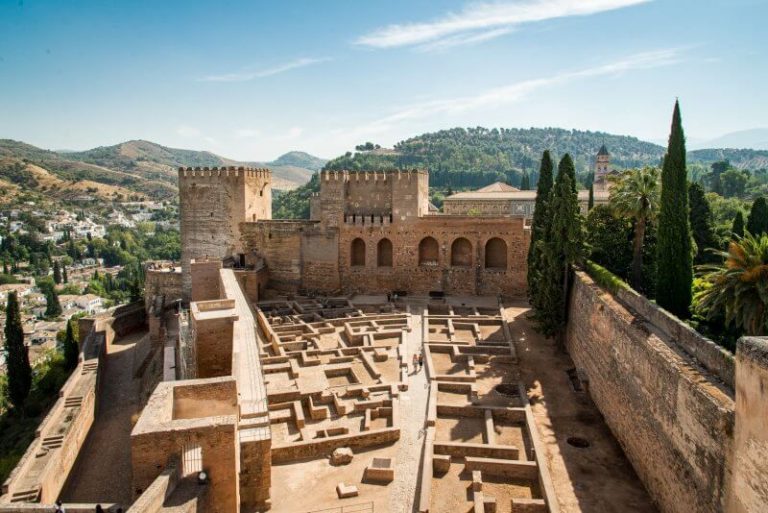
Several towers have been preserved here, among which the most interesting:
- The Cubic Tower, which is part of the wall connecting the Alcazaba with newer buildings. The tower has a panoramic terrace, from which you can see the valley of the Darro and Albayzin rivers – the old quarter of the city of Granada.
- The watch tower is the highest of the local towers, has 4 floors and rises 27 meters.
The Alcazaba also includes the Adarve Garden, planted in the 17th century on the spot where there was a moat between the outer and inner walls of the fortress.
Reservoir Area
The entrance to the Alhambra is the Gate of Justice built in 1348. They are a majestic horseshoe-shaped arch.
Behind the arch are the internal Wine Gate. They connect the Pond area with the Medina residential area.
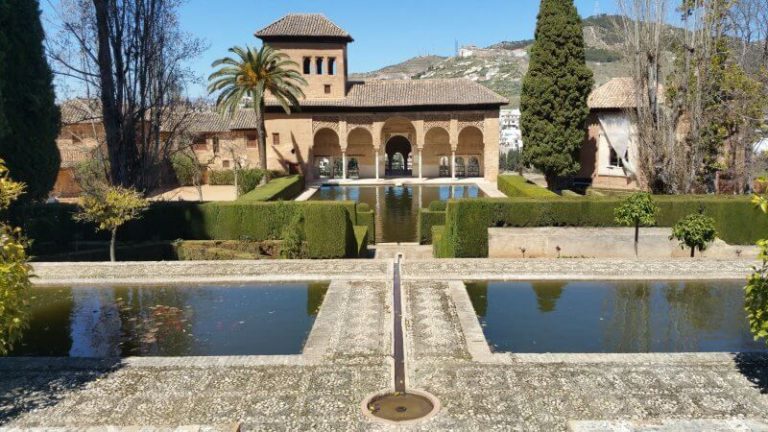
Interesting fact! The French composer Claude Debussy wrote the piano prelude, called the “Gate of the Alhambra,” being impressed by the look of the Wine Gate.
Royal Palace of Nasrid
In the Spanish city of Granada, in the Alhambra, there is the Emir’s palace, which consists of three grandiose castle ensembles: Meshuar Palace, Comares Castle, Lviv Castle.
Due to the destruction and rebuilding carried out by Christians, the original decoration of Meshuar was only partially preserved.
The central place is occupied by the hall where the emir received his subjects, and where the court worked. The walls of the hall are decorated with colorful mosaics and plaster ornaments. The beautiful cedar-patterned ceiling with exquisite inlays of mother-of-pearl and ivory rests on four marble columns.
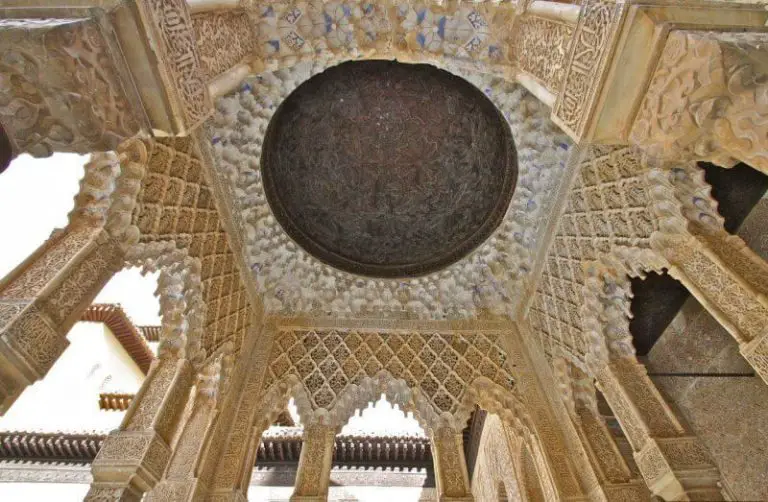
Nearby is a chapel – a small room, the walls of which are painted with prayers from the Koran. In the middle of the eastern wall there is a mihrab – a niche directed towards Mecca. From the chapel, Albaísin, the ancient quarter of Granada, is clearly visible.
To the east of Meshuar is Machuk’s courtyard. Its center is occupied by a picturesque pool, and in the northern corner is a portico and the tower of Machuka towering above it.
The courtyard of the Golden Room connects Meshuar Castle and Comares Castle: in its northern part there is an entrance to the Komares Golden Room.
Komares was the official residence of the Arab ruler, where he received notable guests and foreigners.
The center of this architectural composition is the ceremonial Myrtle courtyard. Its central part is occupied by a large marble pond surrounded by myrtle trees. Water pours peacefully into this pond from two round fountains. Semicircular elegant semi-arches on columns are made on both sides of the Myrtle courtyard, and beautiful portals to the women’s rooms are arranged on the other two sides.
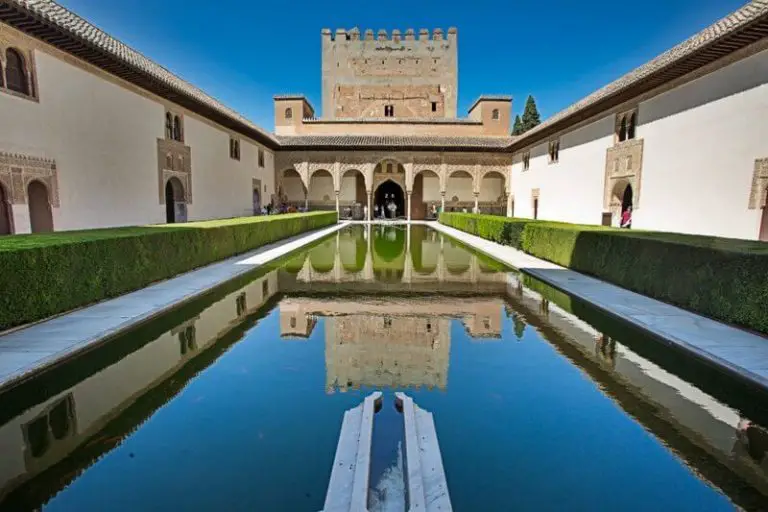
Interesting fact! Myrtle courtyard is considered one of the most picturesque places of the Alhambra in Spain: it is he who is most often depicted in the photographs that are placed in tourist travel booklets.
In the northern corner of the Myrtle Courtyard, Komares Castle rises – this is the highest construction of the Alhambra, which rises 45 meters. It is here that the ensemble’s most luxurious and magnificent building is located: the Hall of Ambassadors. In the middle of the tiled floor is the Alamarov coat of arms (16th century). In the center of the ceiling is the throne of Allah, around – the symbols of the 7 heavens of the Muslim paradise. All surfaces of the walls and arches are covered with stucco molding, exquisite clay carvings, and Arabic inscriptions. On the second tier, in three walls, windows are decorated with beautiful patterned grilles.
This castle is the emir’s private rooms. The style and architecture of the building, built in the 14th century by Mohammed V, demonstrate the clear influence of Christian art.
The central courtyard of the castle, known as the Lion’s Yard, is surrounded by arched galleries. In the middle of the courtyard there is a Lviv fountain: on the backs of 12-stone lions there is a 12-sided marble tank, into which water flows. The courtyard is surrounded by 3 halls: Stalactites, Abenserrachs and Kings.
The Stalactites Hall is a peculiar lobby of the castle. The hall got its name from the ceiling of mukarn, reminiscent of stalactites.
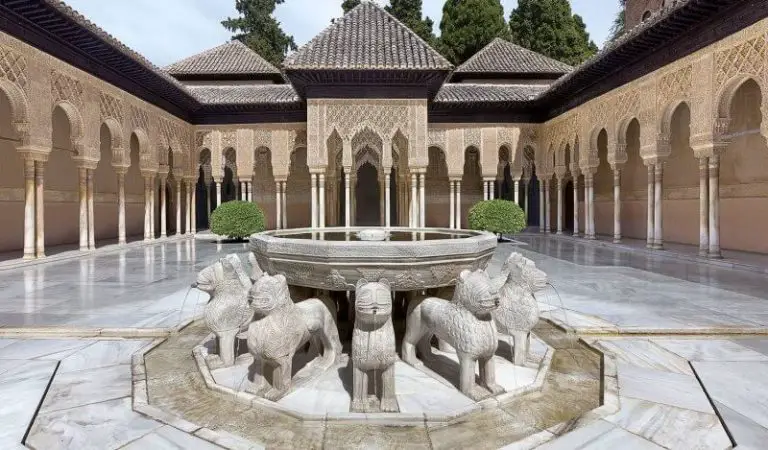
The Abenserrachs Hall is located on the south side of the Lion’s Yard. According to an ancient legend, 37 people from a noble Abenserrach family were killed here because one of the men of this kind allegedly had a relationship with the wife of the Sultan. The most remarkable thing in this room is a star-shaped dome made of mukarn.
The Hall of Kings is located on the east side of the Lion’s Courtyard. The ceilings of this room are decorated with original paintings depicting a peaceful conversation between people in rich oriental clothing, as well as scenes from the lives of ladies and gentlemen.
Among other attractions of the Lviv castle, one can note halls with a rich, elegant decor of a wide variety of materials:
- The Hall of Two Sisters, which served as the main room of the Sultana.
- Mirador Daracha – the closed balcony of the Two Sisters Hall and the first room in the harem suite.
- Biforiev Hall.
- Queen’s Boudoir, created in 1537 for Isabella of Portugal.
Charles V Palace
When Charles V made the Alhambra his summer residence, he decided to build a new castle. The construction, begun in the 16th century, was actually completely completed only in 1957.
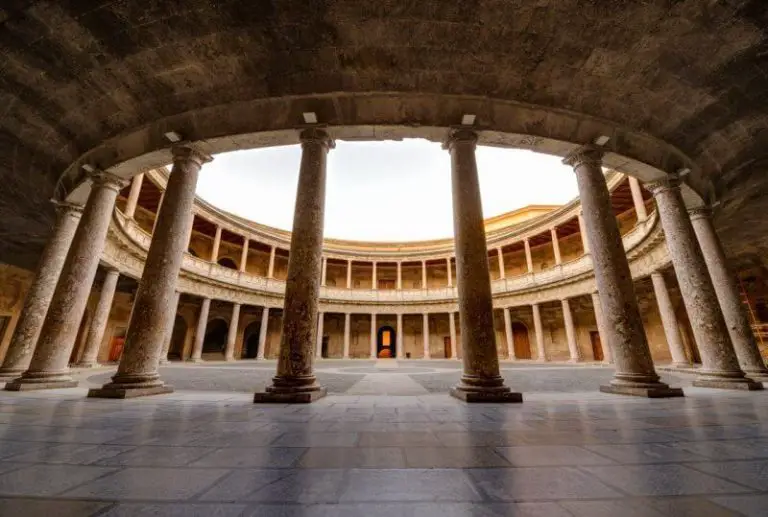
The two-story square castle, designed in the Renaissance style, creates a strong contrast with the rest of the buildings. A spacious rounded courtyard adjoins the castle.
Now working in the castle:
- Museum of Fine Arts of Granada;
- Alhambra Museum;
- Museum of Islamic Art.
Medina or Upper Alhambra
On the territory of the Alhambra in Spain there were not only palaces and a citadel, but also a full-fledged city quarter, which was called the Upper Alhambra. Representatives of the upper classes, as well as artisans who served the whole complex, lived in rich mansions and houses more simply. There were markets, baths, a mosque.
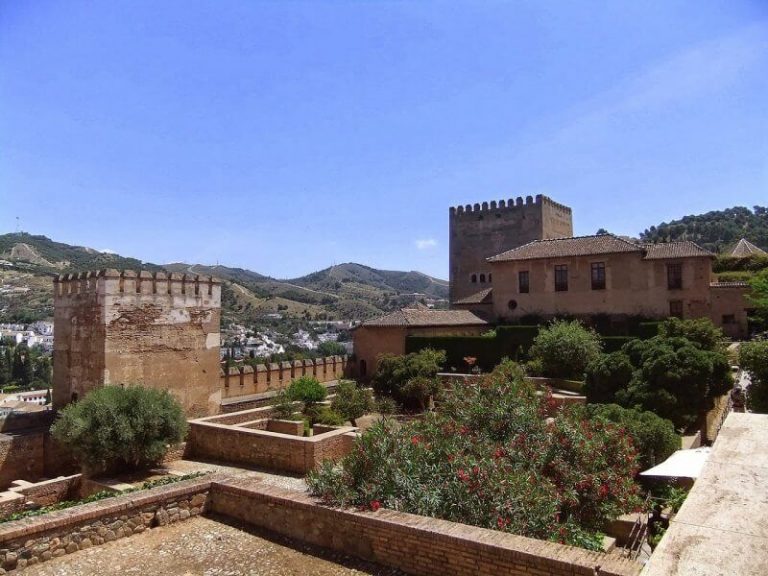
During the Christian era, Medina became abandoned, houses were destroyed, most of the quarter was reorganized into a park. In 1581-1618, the Catholic Church of Santa Maria de la Alhambra was built on the site where the mosque used to be.
Generalife Castle
Generalife Castle, which served as the summer residence of the emirs, is located on a hillside and is connected to the citadel by several roads.
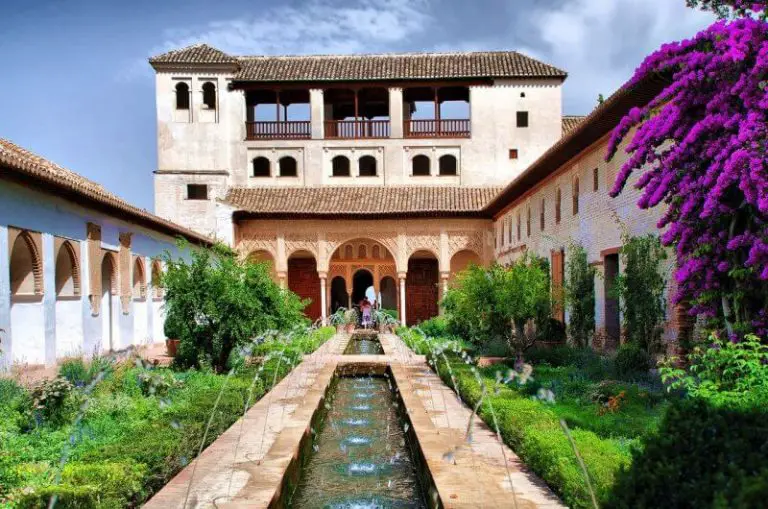
Generalife (XIII century) has a very simple and modest facade, and the most impressive is the courtyard of the Irrigation Canal with lush vegetation. From the courtyard there is access to a panoramic terrace overlooking Granada.
Gardens of the Alhambra
In the Alhambra there are a lot of gardens that are considered part of a castle. Trees, shrubs, flowers – and among this picturesque greenery there are various fountains and water cascades, reservoirs and canals.
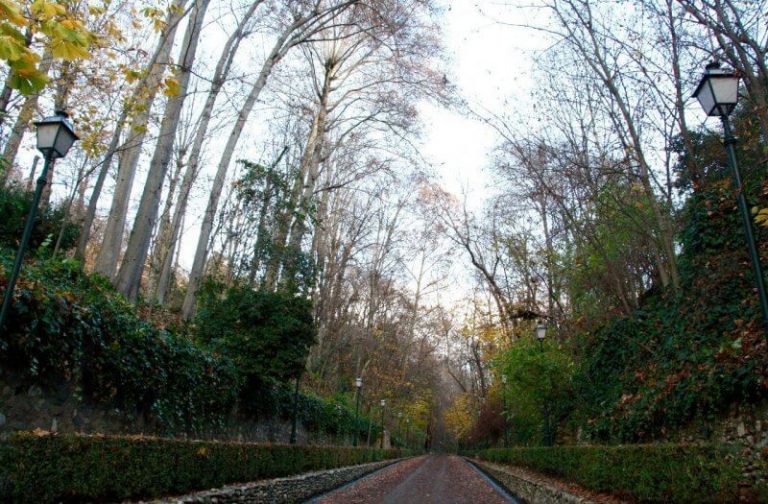
The fortress is surrounded by a continuous park on the north- and south-west sides, which is often called the “Alhambra Forest”. He was landed in the 17th century, under the rulers of Spain, while the Arab emirs left the territory around the Alhambra empty for safety reasons.
Interesting fact! There are various monuments in the Alhambra Forest. One of the paths has a full-length sculpture of writer Washington Irving.
Practical information
The Alhambra Palace complex is located on a hill, in the immediate vicinity of the historic center of Granada. Attraction address: Alhambra, Calle Real de la Alhambra, s / n, 18009 Granada, Spain.
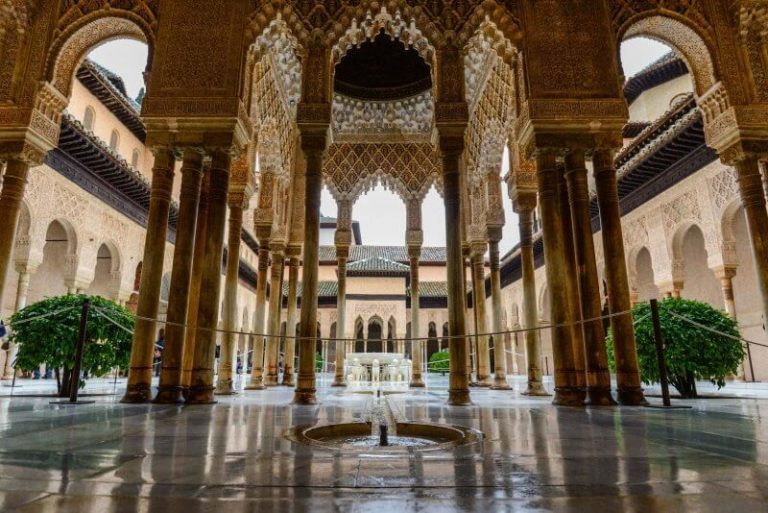
The Alhambra complex in Spain is closed for visits on December 25 and January 1, on all other days it works according to the following schedule:
| April 1 – October 14 | October 15 – March 31 | |
|---|---|---|
| Day visit | Monday Sunday
from 8:30 to 20:00 ticket office 8:00 – 20:00 |
Monday Sunday
from 8:30 to 18:00 ticket office 8:00 – 18:00 |
| Night visit | tuesday-saturday
from 10:00 to 23:30 ticket office 9:00 – 22:45 |
Friday Saturday
from 20:00 to 21:30 ticket office 7:00 – 8:45 |
| Exclusive visit | Monday-Sunday 20:00 – 22:00 | Monday-Sunday 18:00 – 20:00 |
A night visit only to the gardens and Generalife Castle is possible at such a time:
| April 1 – May 31
tuesday-saturday |
September 1 – October 14
tuesday-saturday |
October 15 – November 14
Friday Saturday |
|
|---|---|---|---|
| Visit | 10:00 – 23:30 | 22:00 – 23:30 | 20:00 – 21:30 |
| Cashbox | 9:00 – 22:45 | 21:00 – 22:45 | 7:00 – 20:45 |
Delhi under 12 years old is admitted to the ensemble for free. For other visitors entrance is paid:
- The whole complex – a ticket for a daily visit of 14 €, a night ticket of 8 €.
- Only the Alhambra Forest – in the daytime 7 €, at night 5 €.
An audio guide costs 6 €, is in Russian.
Since visitors have limited access to the Alhambra, it is necessary to buy tickets several weeks in advance, especially in the summer. You can do this on the official site of the attraction: www.alhambra-patronato.es/en/visit/
Prices on the page are for December 2019.
Travel Tips
- The Alhambra is visited by a lot of tourists, therefore it is better to plan a visit on weekdays, in the early morning – at this time there are fewer visitors, in addition there will be a large supply of time for a walk (it takes at least 3-4 hours).
- At 12:30, audio guides may no longer be there – they are quickly taken apart.
- The time indicated on the ticket is the time of entry to the Nasrid royal palace, you need to enter the complex itself 20 minutes earlier. If you are late for more than 15 minutes, then the ticket will simply disappear – at another time they will not let him go.
- When buying a ticket online on the official website, you need to enter passport data, otherwise the document will have to be shown on each control.
- It is forbidden to carry a backpack on the back of the attraction, this is strictly monitored. You need to put it in a storage room, or you can put it on in front of you.
- On the official website of the Alhambra, they offer to download an application with a map and routes. There is little information, and it is presented uncomfortably. It is best to watch documentaries about this attraction of Spain in advance; there are quite a lot of them.
- In most cases, it’s possible to buy a ticket online “day to day” even to the royal Nasrid palace, if you visit the official website in the interval 00: 00-00: 30. The fact is that at midnight they withdraw the reserve from unredeemed tickets.
- There is another great way to get to the Alhambra Palace: you need to buy a Granada Card, allowing free access to many of Granada’s attractions.
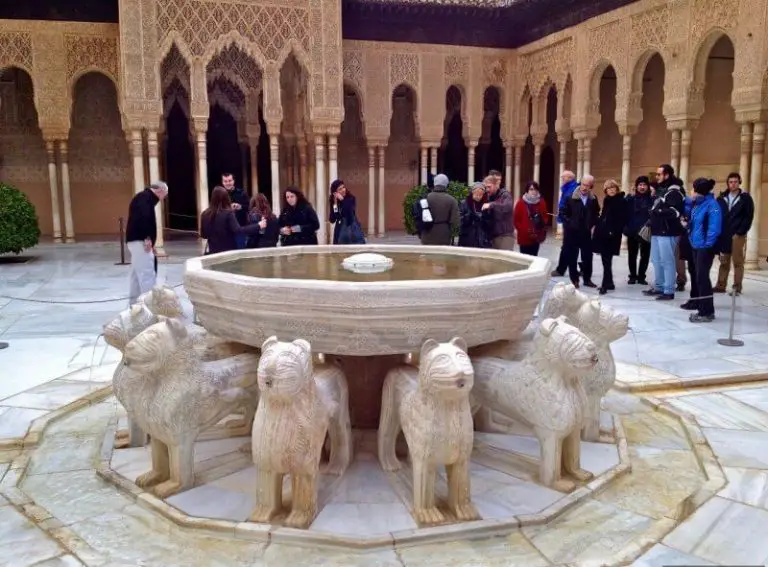
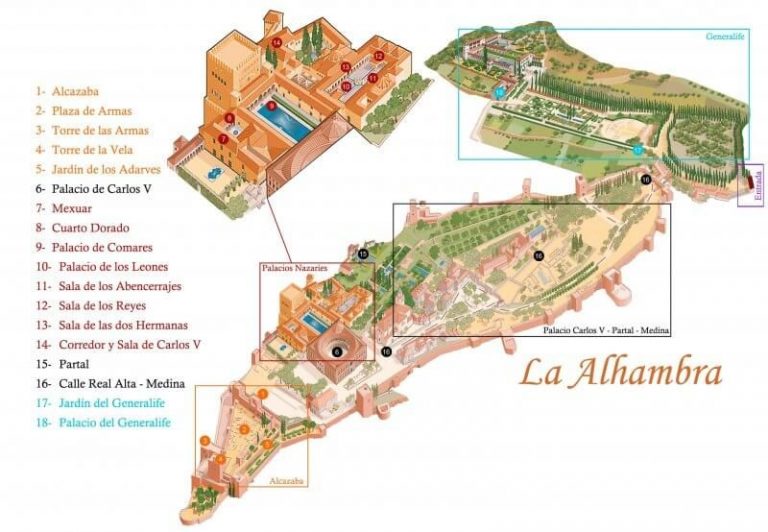
Historical facts about the most famous palace and park complex in Spain:
